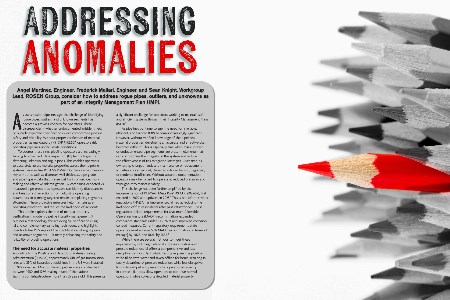Addressing Anomalies
Published by Emilie Grant,
Assistant Editor
World Pipelines,
Angel Martinez, Engineer, Frederick Mallari, Engineer, and Sean Knight, Workgroup Lead, ROSEN Group, consider how to address rogue pipes, outliers, and unknowns as part of an Integrity Management Plan (IMP).

As transmission pipelines age, the challenge of identifying rogue pipes, outliers, and unknown segments has become a growing concern for operators. These discrepancies – whether undocumented, misidentified, or outside expected specifications – can compromise pipeline safety and reliability. Without proper verification of material properties, as mandated by 49 CFR §192.607, operators risk operating pipelines under unsafe conditions.
To address these risks, pipeline operators are increasingly turning to advanced inline inspection (ILI) technologies for detecting unknown and rogue pipes. This enables operators to accurately assess material properties across their pipeline systems. Services like ROSEN’s RoMat PGS Service can measure key attributes such as diameter, wall thickness, pipe grade, and pipe type – data that is essential for informed decision-making and effective risk mitigation. By comparing expected vs measured pipe properties, operators can identify discrepancies and take corrective actions, from adjusting operating parameters to planning targeted repairs or replacing segments altogether. These proactive measures help maintain safe operating conditions and reduce the likelihood of incidents. This article explores the role of material property verification in modern pipeline integrity management. It outlines a methodology for achieving full verification using ILI and complementary sampling techniques, and highlights how tools like PGS support the identification of rogue pipes and unknown segments – ultimately enhancing the safety and reliability of pipeline operations.
The need for accurate material properties
According to the Pipeline and Hazardous Materials Safety Administration (PHMSA), approximately 61% of gas transmission lines and 39% of hazardous liquid lines in the US were installed in 1979 or earlier.1 Most of these pipelines were constructed between 1950 and 1969, making much of the nation’s transmission infrastructure more than 55 years old. This presents a significant challenge for operators working to maintain safe and efficient systems through their Integrity Management Plans (IMPs).2
As pipelines continue to age, the need for a reliable, efficient, and tailored IMPs becomes increasingly significant. However, without verified knowledge of the pipeline’s material properties, developing an accurate and effective plan becomes difficult. This is especially true when rogue, outlier, or undocumented pipe segments are present, elements that can compromise the integrity of the system and reduce the effectiveness of risk mitigation strategies. Over time, as ownership changes hands and maintenance or replacement activities are carried out, these records can be lost, degraded, or rendered insufficient. Without accurate documentation, operators may be forced to operate at reduced pressures and throughput to maintain safety.
This challenge has been further amplified by the implementation of PHMSA’s ‘Mega Rule’ (49 CFR §192.607), first enacted in 2020 and updated in 2023.3 This is one of the stricter regulations PHMSA has implemented aimed at reducing the likelihood of future incidents after past catastrophes. These regulations include requirements for Maximum Allowable Operating Pressure (MAOP) reconfirmation, expanded compliance standards under CFR 192.9, and improved corrosion control measures. Current regulatory requirements state operators must achieve 50% MAOP reconfirmation (in terms of mileage) by 2028, and 100% by 2035.4
While there are several methods to meet these requirements, including hydrostatic pressure testing and pressure reduction, ILI offers a comprehensive and less disruptive solution. Hydrostatic testing requires the pipeline to be filled with water and taken offline for hours, resulting in costly downtime. A pressure reduction, while less disruptive, limits throughput and prevents full operational capacity. In contrast, ILI tools allow operators to continue normal operations while collecting detailed material property information in a non-destructive manner. These tools can help to identify rogue and unknown pipes, verify material attributes across the entire line, and support MAOP reconfirmation, all without interrupting service. The data gathered through ILI also contributes to achieving traceable, verifiable, and complete (TVC) documentation, another aspect of the current regulatory requirements and a necessary component of a reliable IMP. By integrating ILI data into their integrity programmes, operators gain a deeper understanding of their pipeline systems.
To access the full version of this article and get a free trial subscription to World Pipelines, sign up here!
Read the article online at: https://www.worldpipelines.com/equipment-and-safety/09102025/addressing-anomalies/
You might also like
The World Pipelines Podcast - GERG and the future of Europe's gas pipelines
A conversation about the role of GERG in European gas pipeline innovation, research, and decarbonisation strategy. Featuring Alexandra Kostereva, Operations Manager at GERG (European Gas Research Group).
Tune in to the World Pipelines Podcast on your favourite podcast app today.

